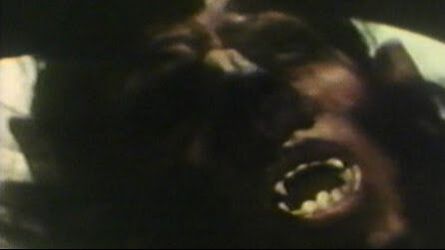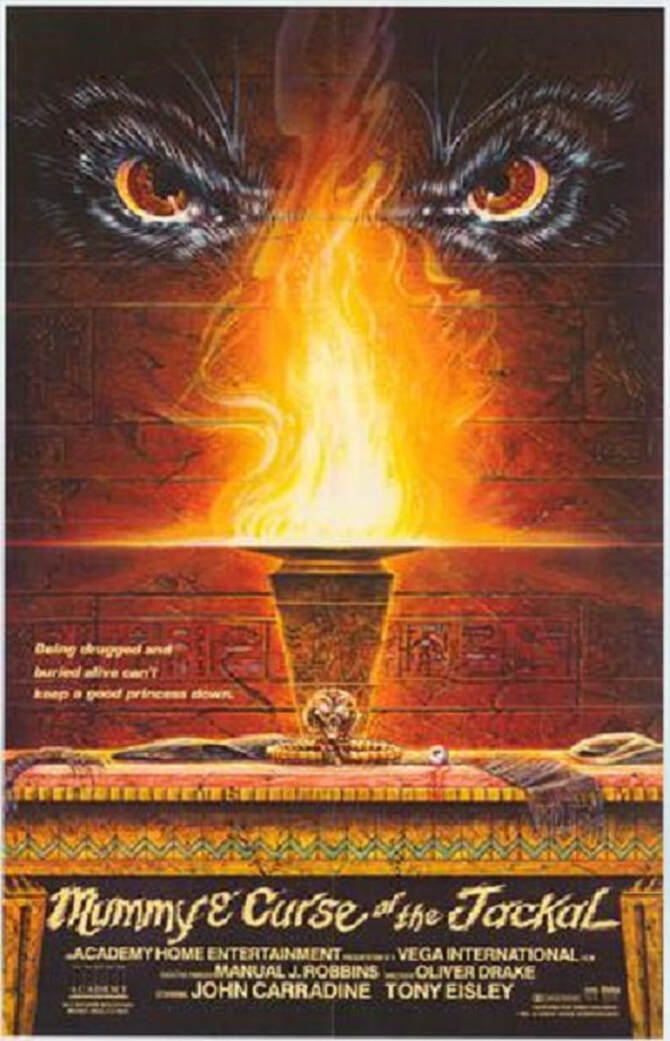 Welcome to a weekly series in which Doris V. Sutherland takes readers on a trip through the history of werewolf cinema... ...The Mummy and the Curse of the Jackals (1969) opens with archaeologist David Barrie (Anthony Eisley) having arrived in Nevada with an astounding archaeological find: the perfectly preserved body of the ancient Egyptian princess Akana (Marliza Pons). According to legend, anyone who stays in the presence of Akana’s mummy during the full moon will suffer the curse of the jackals and turn into a monstrous jackalman—and Dave just can’t resist putting this to the test. He stays alone with the mummy overnight and, after dozing off to sleep, turns into a rampaging were-jackal who kills two nearby police officers. Upon awakening, Dave has no clear memory of his transformation and dismisses the curse of the jackals as mere superstition. His attention is drawn to a different legend: one stating that Akana is merely in suspended animation and will return to life on a certain year—the present year of AD 1969. Sure enough, Akana rises from her sarcophagus, and David sets about introducing the ancient Egyptian to modern America… unaware that for the next few nights, her very presence will turn him into a jackalman. Werewolves had often been teamed up with vampires and mad scientists, and Universal’s Wolf Man met Frankenstein’s Monster a few times. With The Mummy and the Curse of the Jackals, we have a novelty: a team-up between a mummy and a werewolf (and let’s be honest, for all intents and purposes Dave turns into a werewolf: the talk of jackals is only there to give lycanthropy a tenuous Egyptian aspect). The last film to be based around this pairing was Face of the Screaming Werewolf, and that was just the result of mashing a mummy film and a werewolf film together. But while director Oliver Drake and writer William Edwards may have had a pitch with novelty value, what they evidently lacked was a budget. The werewolf costume consists of an oversized mask and gloves that are completely out of proportion with the rest of the actor’s body, making the dreaded jackalman look like a sports team mascot who’s got lost on his way to the pitch—and this is just the start of the problems. Much is made of Akana’s sarcophagus having a glass lid; yet the film clearly couldn’t afford the necessary prop, so the resurrected princess has to mime lifting away a non-existent lid. The soundtrack consists of a few wildly mismatched tracks—including a jazzy sax number, what sounds like a muzak rendition of Toccata and Fugue, and a piece vaguely resembling the James Bond theme—that play in a rotating cycle, switching from one to the other with little regard to what’s happening onscreen. Lead actor Anthony Eisley—co-star of television’s Hawaiian Eye—seems to have viewed the entire production with outright disdain, and delivers his lines as though reading them from semi-legible flash cards. This is a bad film, there’s no room to argue otherwise. But it belongs to that elite class which, as all enthusiasts of obscure horror will be aware, is all too small: The Mummy and the Curse of the Jackals is a film that’s so bad it’s good. The plot is cobbled together from bits of old Universal films; while this is usually a recipe for derivative tedium, this film shows an infectious enthusiasm—even ingenuity—as it tries desperately to mash the mummy and werewolf subgenres together. As though Akana and the jackalman weren’t enough, the story eventually introduces a second mummy named Sirahk, who bears a curious resemblance to the Toxic Avenger and fills the more conventional role of bandaged shambler. The goddess Isis herself pops up to reveal that both the jackalman and Sirahk are Akana’s servants; meanwhile, Sirahk goes in search of his mistress, menacing Las Vegas showgirls in Egyptian costumes along the way (This detail suggests that the film was conceived as a bit of a joke—but if so, the filmmakers have made the commendable decision to play the whole thing straight). All through its runtime The Mummy and the Curse of the Jackals manages to squeeze in oddly endearing details. The cartoonish way that Sirahk smashes through a dressing-room wall. The hilarious roll-eyes-and-die maneuver carried out by the moribund pharaoh in the ancient Egyptian flashback. The early scenes of Dave meeting the resurrected Akana, where he asks her out to dinner and then (after buying modern clothes for her) bashfully explains how to wear a bra, as though the scriptwriter was a giggling 12-year-old boy. The fact that the two mummies’ names were blatantly swiped from Kharis and Ananka in the Universal films, with minor modifications to cover the tracks. John Carradine turning up towards the end as a Van Helsing-like character to explain a load of stuff we’ve already worked out. All of this amounts to a genuine kitsch masterpiece: a relentlessly silly film that really does deserve a watch from anyone who appreciates a good bad movie. And just when you thought it couldn’t get any odder, the film’s jackalman would return in—of all things—a porn flick, Dracula the Dirty Old Man. But that’s a topic for next week’s review… By Doris V. Sutherland
2 Comments
Bob Gassel
2/14/2021 10:46:26 am
My dad was an investor on this, here's the story as I know it...the film ran out of financing before it was completed, and all of the footage was confiscated by some contractor who hadn't been paid.
Reply
Julian Grainger
12/8/2021 03:35:50 am
Yes please, Mr Gassel! To see the original script and production stills would be quite amazing. I've been obsessed with the proeuctions of Las Vegas-based Vega International for years. Have you ever heard of other Vega titles such as "Thunder Circle", "Quantrill's Raiders" and "Dracula"?
Reply
Leave a Reply. |
Archives
March 2023
|


 RSS Feed
RSS Feed